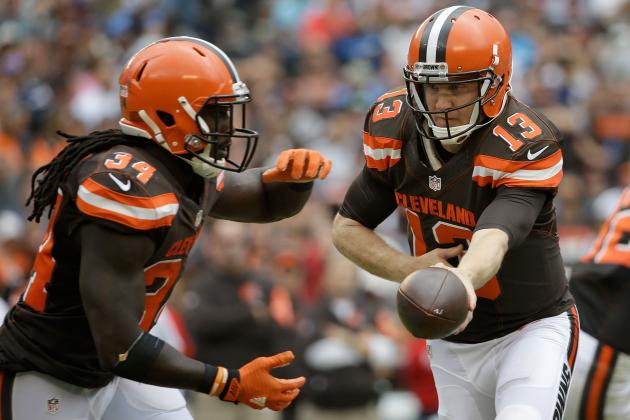Last summer, Browns running backs coach Wilbert Montgomery ripped his young charges for not stepping up. The leading rusher in 2014, Terrance West, was soon traded away for squat. The oldest of the bunch, Shaun Draughn, wound up on the practice squad until the 49ers came calling and gave him the first six starts of his career. The tight ends and rookie fullback generally were of little help in fashioning an effective ground attack. The rushing production improved later in the season, but it was a lost cause by then.
Enter offensive-minded head coach Hue Jackson and his old friend Kirby Wilson, the Browns’ new running backs coach/run game coordinator. Let’s look at the stable of backs they inherit:
Running backs
Currently on roster: 6
Duke Johnson — The rookie third-rounder established himself as a reliable weapon, particularly as a receiver, catching 61 of 74 targets. He recovered from preseason hamstring and concussion problems to play all 16 games and finish third on the team with 913 yards from scrimmage. Like the Browns as a whole, Johnson’s rushing stats weren’t impressive, with just a 3.6 average and no touchdowns. But he excelled in passing situations and formations, protected the football, and showed the quickness and agility to succeed in this league.
Isaiah Crowell — The Browns’ leading rusher with 706 yards (3.8 average), the Crow also managed to play every game, as he did in his 2014 rookie season as well. He scored four of the team’s five rushing touchdowns, doubled his receiving output, and didn’t fumble or drop a pass in 204 touches. While he has a nice straightforward burst, hesitation tended not to pay off behind this line, and he showed a troubling propensity for losing his footing. He was stuffed for no gain or a loss on 14% of his carries. At just 23 years old, the undrafted Crowell has room to improve further, as his explosive style is not easily overlooked.
Terrell Watson — A bruiser who broke most of Christian Okoye‘s college records at Azusa Pacific, Watson was the first player signed since Jackson arrived. That’s no accident; he spent 2015 on the Bengals’ practice squad. For a 240-pounder, he has good speed, and he’s regarded as a hard worker and high character guy. We’ll see how much he’s rounded out his game in terms of lead blocking, pass protection, and special teams contributions.
Raheem Mostert — The former Purdue burner bounced around to four teams in his rookie year after going undrafted. He led the league with 351 yards from scrimmage during the preseason. But his obvious niche is on special teams. Though he had just 19 kickoff returns, his 27.9 yard average would have ranked sixth in the NFL. He’s probably undersized for a significant role in the backfield, but, as they say, 4.28 speed in the 40 can’t be taught.
Glenn Winston — Once a blue-chip prospect, character concerns and injuries have limited him to just one fumbled NFL carry. He’s impressive in pads, a solid 220-pounder, but he’ll be 27 already, so if he’s a viable Jeremy Hill-type complement to Johnson’s Giovanni Bernard, it’s now-or-never time.
Malcolm Johnson — The sixth-rounder out of Mississippi State played 12 games and started five at fullback as a rookie. A tight end and receiver in college, Johnson struggled to contribute to a constructive blocking scheme for his fellow backs and was generally panned by the likes of Pro Football Focus. A groin injury ended his season prematurely; the Browns averaged 161 rushing yards in his four-game absence after topping out at 116 yards with him active.
Analysis and outlook
This will be Wilson’s 19th year coaching NFL running backs, so if anyone knows what it takes to get the most out of a team’s talent, it’s the guy who’s coached the likes of Adrian Peterson, Emmitt Smith, Thomas Jones, Curtis Martin, Edgerrin James, and Mike Alstott. He coaxed strong Steeler seasons from Willie Parker, Rashard Mendenhall, and Le’Veon Bell as well.
Does he have that kind of talent in Cleveland? Well, there’s not a single name you’d identify as a feature back, but the Browns have a young ensemble with a variety of useful skills. For a team with myriad personnel needs, making a substantial investment in a premiere running back doesn’t make as much sense as maintaining the offensive line and fortifying the other blocking that makes for a productive running game — i.e. from tight ends, fullbacks, and wide receivers.
But the Browns may have as many as 11 draft choices, and it’s generally a good idea to take a back or two somewhere down the line, as even later-round choices can contribute, and it’s a high-risk position that favors fresh, young legs.
I generally don’t favor signing free agent RBs due to the age and mileage factor, but you can’t entirely rule out the Browns making a move to add a proven producer such as the Jets’ Chris Ivory or the Dolphins’ Lamar Miller, who preceded Johnson at the U but is still just 24.
And many an Ohioan will fantasize about Ezekiel Elliot in orange and brown. The Buckeye star is bound to be the first back off the board, as there’s not a team in the league his talents wouldn’t help. But the QB position takes priority for the Browns, and Elliot will be long gone by their next scheduled pick at 32nd overall.
Expect the incoming coaches to believe they can further develop the runners already in house, perhaps adding a low-risk signing and/or draftee to the mix. The Browns may not have an elite back, but they have a young cast with some playmaking qualities. Their success will come with the bolstering of the offense around them.
